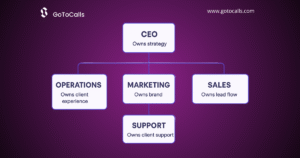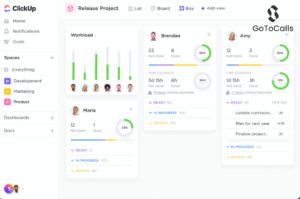How to Communicate Roles So the Team Actually Hears It

You’ve built a capable team. You delegate, you give direction, you check in, yet somehow, your “delegation” always circles back to you.
You explain expectations, but decisions keep coming back for approval.
Then you think, “Didn’t we already talk about this?”
And before long, you’ve become the clarity center for everyone.
It’s not that your team doesn’t care; it’s that your system isn’t speaking for you.
Here’s the trap many leaders fall into:
They believe the issue is communication, when in reality, it’s infrastructure.
You can repeat a message 10 times, but if there’s no structure supporting it, clarity fades the moment the meeting ends.
The real reason your team doesn’t hear you is because:
- Clarity lives in conversation, not in systems.
- Ambiguity feels polite, but it kills ownership.
- Context stays in your head instead of being documented.
- Shared ownership becomes shared confusion.
You don’t need louder communication.
You need clarity that lives inside your operations.
Now let’s talk about how to build that.
Redefine Your Communication From Talking to Designing

Most leaders try to fix role confusion by “communicating better.”
That 2-hour meeting on communicating about tasks again isn’t the solution; you just need a better structure.
Communication that sticks is communication that’s built into the system.
At GoToCalls, we help leadership teams move from verbal to structural clarity.
Here’s how to build that kind of system.
How To Define Ownership, Not Just Tasks
When roles are unclear, the issue isn’t usually workload but ownership.
A task describes what someone does.
Ownership defines what they’re responsible for.
An example of how ot define ownership would be:
Don’t say; “James handles client reports.”
Instead say; “James owns client reporting: accuracy, timeliness, and client follow-up.”
Each role should clearly define:
- Primary Accountability: What outcomes they fully own.
- Boundaries: What decisions belong elsewhere.
- Interfaces: Who they collaborate with, and where overlaps start and stop.
When people know what they own, they stop waiting for direction and start acting with confidence.
When ownership is vague, initiative dies.
Visualize It Because People Understand What They Can See Better
Words fade. Visuals stick.
If clarity lives in your Google Docs, it’s invisible.
If it lives in your workflow, everyone sees it, every day.
You need visual clarity tools that make ownership unmistakable:
- Role Maps: A simple snapshot showing every seat and its core accountability lines.
- Handoff Charts: Visual transitions that show when one role’s finish line becomes another’s start line.
- Decision Matrices: Who decides, who contributes, who executes, and who needs to be informed.
When your team can see how they connect, accountability stops being abstract.
It becomes part of how the business operates.
Embed Role Clarity Into Everyday Systems

Clarity fades fast if it isn’t reinforced daily.
Make ownership visible where people work, not in a file they never open.
Here’s how:
- Tag owners, not just assignees, in your project tools.
- Use naming conventions that reflect ownership (e.g., “Owner – Task”).
- Connect metrics and KPIs to each role’s outcomes.
- Include accountability check-ins in weekly meetings.
This way, communication happens automatically, not because you’re repeating yourself, but because your system keeps repeating for you.
Create a Rhythm of Reinforcement
Even a clear system will erode if it’s not revisited.
That’s why great leaders build rhythms that sustain clarity over time.
Try this cycle:
- Weekly: Quick alignment checks; “Any blurred lines or overlaps this week?”
- Monthly: Review ownership where recurring issues appear.
- Quarterly: Revisit role maps as the business evolves.
This keeps structure alive, so when priorities shift or new members join, clarity adjusts instead of collapsing.
Role clarity is dynamic.
The best teams treat it like infrastructure maintenance; constant, intentional, and essential.
Communicate Roles as Empowerment, Not Control
One reason role definition feels uncomfortable for leaders is that it sounds restrictive.
But in reality, clarity should create freedom.
When your team knows exactly what they own, they can move faster, make decisions confidently, and take full initiative because they know where their authority begins and ends.
You can even frame it like this:
“I’m not limiting your scope, I’m giving you the freedom to own this area completely.”
Boundaries don’t box people in.
They create space for high performance.
Build a Culture of Accountability Without Micromanagement
When roles are clear, accountability becomes natural, not forced.
Here’s how to build that culture:
- Normalize Ownership Language: Say “Who owns this?” instead of “Who’s working on this?”
- Celebrate Autonomy: Recognize when someone made a decision independently and it worked.
- Model It: As a leader, make your own role boundaries visible. (“That’s not my call that’s Operations.”)
The message becomes:
“We trust you to lead your area.”
That’s how you turn communication into empowerment.
Elevate With Systems, Not Only Supervision

True scalability happens when your system communicates better than you do.
When expectations, ownership, and accountability are built into the workflow, leadership stops being about reminders and starts being about results.
At GoToCalls, that’s exactly what we build: clarity systems that let you lead without chasing alignment.
Here’s how we do it:
- Audit your current structure. We identify where ownership leaks, overlaps, or bottlenecks exist.
- Define roles and handoffs. We translate job titles into operational accountability.
- Visualize it. We create role maps and handoff systems your team can see in seconds.
- Integrate it. We embed those systems directly into your tools and check-ins.
- Coach it. We help your leaders maintain the rhythm that keeps it alive.
The result?
- Less explaining.
- Faster action.
- Smarter delegation.
- A business that runs with or without your voice.
You stop being the bottleneck and start being the architect of clarity.
If your team isn’t “hearing” your role communication, it’s not because they’re ignoring you.
It’s because your system isn’t reinforcing you.
Real communication isn’t about repetition, it’s about design.
When clarity is built into your systems, your team doesn’t just hear you once, they operate from your vision every day.

